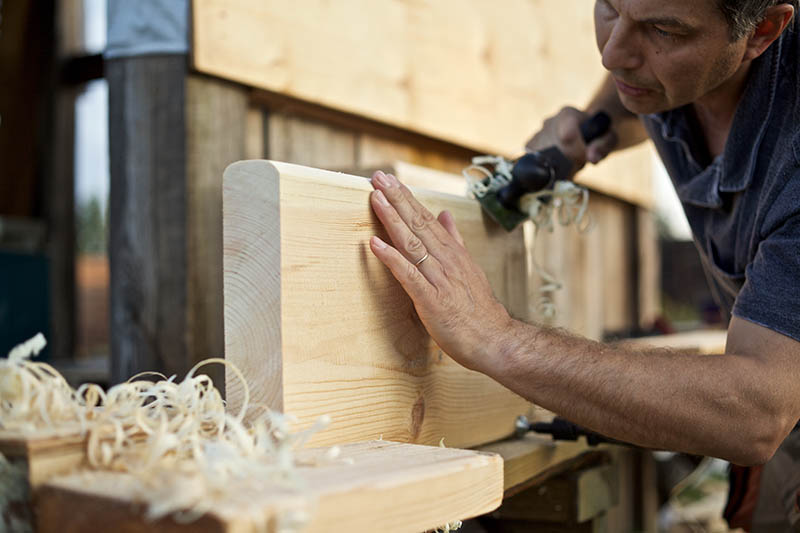11 Carpentry Myths and Misconceptions: Everything You Need to Know!
-

- Last updated:

Carpentry is an extremely intriguing field. The Internet and television are filled with images and stories of people creating amazing things in their own personal workshops. However, when it comes time to start, many people get stopped by a series of myths and misconceptions that cloud the understanding of carpentry in the 21st century. Carpentry is seen as expensive, dangerous, or just a hobby. But these things are not necessarily true.
Here are 11 myths and misconceptions about carpentry that you should know.

The 11 Carpentry Myths and Misconceptions
1. You Need a Large Workshop to Work

Prospective carpenters often get hung up on workshop space. There are many would-be carpenters that hesitate to start because they don’t feel like they have the workshop space required to get started. But you do not need a large shop to make quality items. You can get by with small spaces. Even a small corner of a garage is enough to get started. You really just need a single table to do most simple projects. If you are interested in carpentry, don’t let the fact that you don’t have thousands of square feet of workspace prevent you from tinkering and getting involved in the craft.
2. You Need a Large Number of Tools to Finish Projects
Another misconception about carpentry is that it requires hundreds or thousands of dollars of tools to get started. That could not be farther from the truth. Carpenters have been working and building things with hand tools for hundreds of years. Sure, hand tools aren’t the newest, greatest, or easiest tools to use in the 21st century, but they are still extremely functional. You can get started as a carpenter with a screwdriver, hammer, hand sander, hand saw, and some basic clamps. You can even get miter boxes to make precise cuts with a simple hand saw. This can save you hundreds of dollars and allow you to experience the phases of carpentry without investing too much money.
Carpentry requires a vision, a plan, materials, and the work itself. You can start working through the planning phase and the idea phase without any expensive power tools. Start small. Start simple. Feel out if you enjoy the work, the planning, and the feeling of accomplishment before investing in more expensive tools.
3. Carpentry Is Too Expensive to Get Into

Between the misconceptions about tools and workshop space, many people think that carpentry is prohibitively expensive to get into. But that is not true. You can get started for just a couple of hundred dollars with some hand tools and a table. You might not be able to construct a solid cherry armoire when you are first starting out, but you can absolutely build basic things on a budget. Carpentry can certainly get expensive, but it does not have to be.
4. Carpentry Is Too Complicated to Learn Later In Life
Carpentry is one of those fields that many people think is too complicated to learn as an adult. Some people feel that if they didn’t start learning when they were young that it is too late to get started as a second career or late-stage hobby. That is not true. Carpentry starts very basic with some core concepts that are easy to learn. Many projects are simply a series of angled cuts and some screws and glue. If you can sand wood and make miter cuts, you can be a carpenter. Anyone can learn the basics in a matter of weeks if they put their mind to it. Complex carpentry simply builds upon basic carpentry concepts. It is never too late to learn a new skill, carpentry included.
5. Woodworking Tools Are Dangerous

Some people get skittish about using certain carpentry tools. Saws can be intimidating, and certainly, there are accidents that occur in workshops. However, most woodworking tools are very safe. Hand tools, for example, are incredibly safe, and they can be used to start a path in carpentry with very little risk. More complicated tools like table saws and routers might look intimidating, but as long as you read the user manual, follow all safety instructions, and take your time, the risk of an accident or injury is very low. Most accidents happen due to a lapse in concentration or when someone tries to use a tool for an unintended or improper purpose.
You always have to be on guard around running power tools, but you should not let your fear of an accident get in the way of embarking on a career or hobby in carpentry.
6. Carpentry Chemicals Are Dangerous
Carpentry can involve a slew of different chemical materials, including glues, stains, varnishes, stripping agents, and more. This might sound alarming, but these chemicals are harmless if managed properly. The key to avoiding adverse effects of dealing with carpentry chemicals is to follow all instructions to the letter and use them in a well-ventilated area. If you are worried about it, you can also wear a respirator. Not all carpentry uses chemicals. You can do natural carpentry and just focus on the wood—no need for any smelly VOCs. As long as the chemicals are managed properly, they will pose no serious risk to your health.
7. The Dust Is Dangerous

The presence of persistent saw dust turns a lot of people off from carpentry. Sawdust can be dangerous if it is inhaled consistently over time, but on a day-to-day basis, the dust poses minimal risks to your health. Wear eye protection. Wear a mask if you feel the need. Have a dust mitigation plan in place. These things will prevent the dust from adversely affecting your health. Saws create the most dust. If you are not using saws, then the dust levels will be much lower than if you are using a table saw all day. Be aware of the dust. Have a plan for the dust. But don’t let the dust turn you away from carpentry.
8. The Dust Isn’t Dangerous
Similarly, some people play down the dangers of persistent dust. The dangers of dust contamination should not prevent you from starting a venture in carpentry, but you should also not ignore the problem either. Indoor workshops need dust mitigation systems in place to keep people safe. Do not ignore the dust. You need to sweep it up, blow it away, or have a filtration system to keep the air clean. Sometimes, a large shop fan is enough to keep the dust down if you blow it out of a garage door. The dust is not extremely dangerous, but it can be dangerous if you inhale it consistently. Do not ignore the dangers of continuous dust inhalation but also do not let the prospect of dust prevent you from getting into carpentry.
9. You Can Build It Yourself Cheaper Than You Can Buy It

Many people want to get into carpentry because they think they can build things cheaper than they can buy them at the store. That is not always the case. Large operations work on economies of scale. Factories and professional workshops can buy materials in larger quantities and for better prices than individuals. Things like stains and sandpaper are marked up to high degrees at local hardware stores, which add extra costs that you do not see when buying something at the store.
However, while some stuff is cheaper to buy in-store than it is to make yourself, one thing that you do have control over is the quality. Stores save money by stocking lower quality items made from cheap materials. You can increase the quality by controlling your project and investing in better materials, but that might also raise the price tag by quite a bit.
10. Carpentry Is an Outdated Trade More Akin to a Hobby
Carpentry is by no means an outdated trade. There are plenty of casual carpenters, novices, and hobbyists doing great work, but you can also forge a career as a professional carpenter. Carpentry is an integral part of most construction projects. Rough carpenters are responsible for completing the framing of a building, while finish carpenters tackle the detailed work. Carpentry is still responsible for everything from corbels to built-ins to cabinets. Carpentry is a trade skill that is alive and well, and there are plenty of opportunities to go pro if that is your wish.
11. Carpentry Jobs Take Too Long for Novices

Some people are worried that carpentry jobs take too long to complete, especially for novices. People worry that they will never be able to finish a project in a reasonable amount of time without experience. That is not the case. There are many simple jobs that can be completed in a few hours, an afternoon, or just a couple of days. You do not need to set aside days or weeks to complete certain projects as a beginner. While experience does make jobs go faster, even novices can find projects to tackle in a single afternoon of free time.
Certain large projects will take longer than others, and certainly, some intricate projects might take a few weeks to complete. That is not necessarily the norm. If you are worried about the time investment for carpentry projects, do some research and find simple projects to help you get your feet wet.

Conclusion
Carpentry comes with a lot of myths and misconceptions that can turn people off from exploring the field. Carpentry is a modern and thriving field with some risks, but getting started is not as hard as people believe. As long as you do your research, follow instructions for your tools and materials, and have a plan, carpentry can be extremely accessible. It is time to start dispelling these misconceptions around the field of modern carpentry.
Featured Image Credit: FabrikaSimf, Shutterstock
Contents
